Dogon Genetic Symbolism, Part I
Updated June 2023
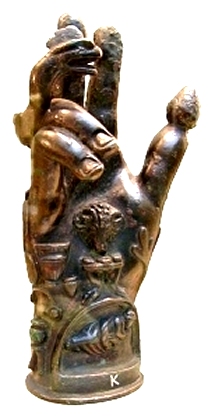 Bronze hand 1st-2nd century CE.http://en.wikipedia.org/wiki/ Sabazios#mediaviewer /File:HandOfSabazius.JPG Author: Mike Young Located at the British Museum |
In Day of the Fish, I devote an entire chapter to hand and foot symbolism because of it importance to the Dogon religion. The alien Nummo didn't have hands and feet like humans so depictions of hands and feet were used in the religion as genetic symbols.Shannon Dorey, Day of the Fish p. 146
Hand and Foot symbols appear in many ancient cultures. The bronze hand above was used in the worship of Sabazius, a god of Thracian or Phrygian (Ancient Turkey) origin, who became popular in the Roman Empire.http://en.wikipedia.org/wiki/ Sabazios
Hands decorated with religious symbols were designed to stand in Thracian or Phrygian sanctuaries or, like the one above was attached to poles for processional use.Dorey, The Rose p. 370 Stone hands were likewise used in the Dogon religion to aid in the instruction of diviners to the religion. A wooden 'hand' of sene (Acacia Faidherbia albida) was also used by the diviners and was likewise known as the hind paw of the Jackal. The Nummo's failed experiment not only affected humans but all plant life, which is what the sene tree represented.Shannon Dorey, Day of the Fish p. 151
In Europe during the first eight centuries of Christianity, and even until the twelfth century, the Christian God was invariably represented by a hand, the origin of which the symbol was thought lost in pagan obscurity. When the fourth and fifth fingers were bent downwards as is shown on the bronze hand above, the hand formed the well recognized symbol of benediction, used as a blessing at the end of the Christian mass. A hand on a pole also appears on page 27, of the Kingsborough and Förstemann versions of the Maya Dresden Codex and which I refer to in Day of the Fish.Dorey Day of the Fish p.370
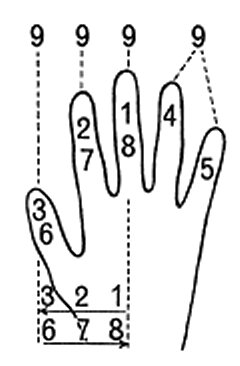 Numerical Value of FingersShannon Dorey, The Master (Mistress) of Speech p. 155 |
In the Dogon religion the fourth finger symbolized the genetic makeup of the Fourth Ancestor, who was identified with males, the Earth, and humans, whereas the fifth finger symbolized the genetic makeup of the the Fifth Ancestor, who was identified with females, the Nummo's world and heaven. The Dogon elder Ogotemmêli said the fourth and fifth fingers "represented the mating of twins of opposite sexes, that is to say of two beings forming only one."Marcel Griaule, Conversations with Ogotemmêli p.151 This was associating the union of the Fourth and Fifth Ancestors with the creation of humans and single-sexed beings. All of the Eight Nummo Ancestors were symbolized on the fingers of the hand, which was used by the Dogon to tell which families could unite for procreation. Only the Fourth and Fifth Ancestors appear on separate fingers.
The First and Eighth Ancestor appear on the middle finger, the Second and Seventh Ancestor on the index finger and the Third and Sixth Ancestors on the thumb. The numbers, which I believe have to do with the genetic makeup of the Ancestors, had to add up to nine as shown on the hand above. The hand showed which of the Ancestors' offspring could unite for procreation. Griaule reported that "the system of marriages was so arranged that the sum of the numbers representing the rank of the two families was always 9, which is the rank of chieftanship."Shannon Dorey, The Master (Mistress) of Speech p. 155
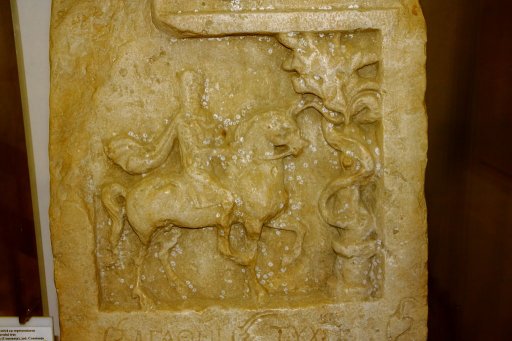 Thracian Sabazius on a Horse with Serpent around a Tree.http://commons.wikimedia .org/wiki/File: Sabazios_MNIR_IMG_6299.JPG Romanian National History Museum. Thracian horseman. Author: Cristian Chirita |
Sabazius was the nomadic horseman and sky father god of the Phrygians and Thracians.http://en.wikipedia.org/wiki/Sabazios My research reveals that Sabazius was also associated with the Dogon god Amma. Like Sabazius, Amma was the horseman and sky father of the Dogon people. The Dogon word in the Wazouba language for "horse" meant "power." A horseman, symbol of Amma, was sometimes placed next to or on a horse, which was a symbol of the Nummo.Shannon Dorey, The Rose p. 52
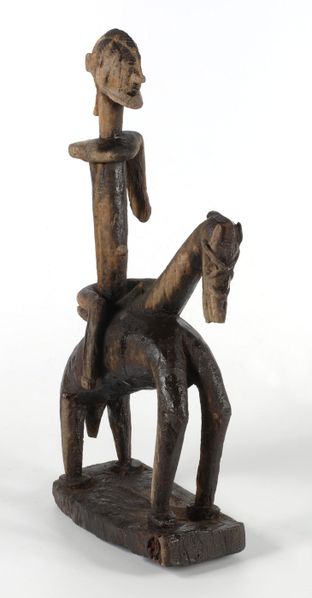 Photo by the Tropen Museum, Nederlandshttp://commons.wikimedia.org /wiki/File:COLLECTIE_TROPENMUSEUM_ Houten_beeld_van_een _ruiter_vermoedelijk_ voorouderfiguur_TMnr_4133-11.jpg Photo by the Tropen Museum part of the Royal Tropical Institute, Nederlands |
This is a Dogon Wooden Statue of Amma as the horse rider circa 1500 - 1900.
The Dogon compared the transformation of the Nummo and the moving of the Nummo's ark or spaceship, to the rapid expansion of beings on the Earth, as depicted by the path of the horses to the four directions of space. The Dogon said that "with the chariot (ark), the horse (Nummo) brought forth the Word." The "Word" symbolized DNA in the religion.Shannon Dorey, The Nummo p. 58 On the back of Sabazius' bronze hand shown above is a caduceus symbol, an ancient symbol which I associate with DNA.
Amma's hands, shown below left, which were known as the "double placenta", were depicted as two V's pointing towards each other. I believe Amma's "hands" represent duplicated chromosomes, which are shown below right.Shannon Dorey, Day of the Fish p. 148
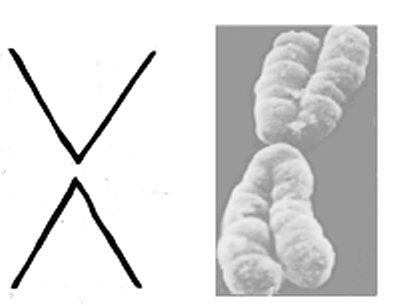 Amma's Placenta Duplicated ChromosomeShannon Dorey, Day of the Fish p. 149 |
Similar images of Amma's hands forming two points appear in yoga, which I refer to in my book, The Nummo. In yoga, it is said that the divinity meets the devotee at the level of the heart, which is the fourth chakra, "the divinity is coming down and the devotee reaching up." The symbol of this chakra is two overlapping triangles. Reaching up suggests a hand, indicating that the symbol of the triangle was also identified with a hand in yoga. The fourth chakra may have some ancient association with the genetic make up of the Fourth Ancestor, symbolized by the fourth finger of the hand in the Dogon religion.
Joseph Campbell associates the triangles of the fourth chakra with the handprints that are visible in many primitive shrines. "In the Paleolithic ordination caves, going back as early as 30,000 BCE, one finds handprints of the devotee who touches the realm of the divinity." He also refers to two footprints used in yoga instead of the two triangles to represent the same thing.
Perhaps you have seen images of the Buddha's footprints, which have the symbol of the dharmacakra, 'the wheel of law,' engraved in the middle of the foot. You can go to Jerusalem and see the place where Muhammad left his footprints on the rock from which he ascended to heaven; it is around this rock that the great Al-Aqsa mosque was built. There are even little towns in India called 'the footprint of Visnu' [also Vishnu] where Visnu came down and left his footprint.
The single footprint of Vishnu is important because the Nummo and the Eight Ancestors only had a fish tail so they were perceived as having a single foot.Shannon Dorey, The Nummo p.97
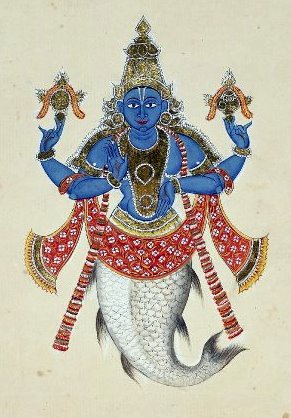
Matsya, avatar of the god Visnuhttp://commons.wikimedia.org/ wiki/File:Matsya_avatar.jpg
This is a picture of Matsya, an avatar of the Hindu god Visnu, from the British Museum. It is found on laid and water-marked European paper, dated 1816. A silk sash is draped over his elbows and has an intricate design. The picture either depicts Vishnu with a fish tail or depicts him emerging from the mouth of a fish. Either depiction associates this picture with the Dogon religion. The Eight Ancestors all had fish tails and human upper bodies and Lébé was vomited forth from the mouth of the Seventh Ancestor (The Mistress of Speech)(see below).Shannon Dorey, The Nummo p.97
Other symbols, which appear on the bronze hand above, are found in the Dogon religion including the ram and the serpent. Although the Nummo had fish tails, they were associated with serpents because of the way they moved on land, and it was the "Serpent" that Ogotemmêli most often used when referring to the Nummo. When they were in their spaceships the Nummo were known as "Celestial Rams." This is because the spaceship had tubing that curved around like the horns of a ram.
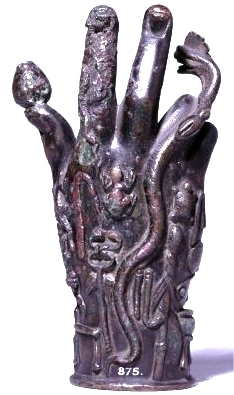
Back of Bronze Handhttps://www.tumblr.com/ search/hand+of+sabazius
On the back of the bronze hand, shown above, are a turtle and frog image. Frogs are amphibians like the Nummo and my research indicates they were a symbol of the Nummo in many ancient religions including the Goddess religion of Old Europe. The Greek goddess Artemis was worshiped as a toad in Egypt, Italy, and Lithuania and according to Marija Gimbutas, Sheela Na gig, a figure which has been found incorporated into old churches in medieval Ireland and England was none other than the ancient frog or toad goddess, the birth giver and regeneratrix inherited from the Neolithic.Shannon Dorey, Day of the Fish p.44 The Nummo were female beings and a breast appears on the frog in this image.
Both the sun and the turtle symbolized immortal beings and what humans were supposed to eventually evolve into. To correct the failed experiment, it was said that Amma cut off the four corners of Ogo's (the Jackal's) placenta and transformed them into a turtle. The turtle is discussed in detail in The Nummo. In the Dogon religion there was both a water turtle and a land turtle. The land turtle was the equivalent of all animals on Earth. The water turtle was the equivalent of the sun or the Nummo. The Hogon and the heads of families kept a tortoise in their homes as the "guardian of the world" and gave it a bit of their food before meals.Shannon Dorey, The Nummo p.145
In Dogon mythology, the Smith's hook was also an important part of the smithy, and associated with the Robber's Crook, which was identified with the stolen fire and the genetic failure. The hook appeared on the Dogon totemic sanctuary. A hook likewise appears on the back of this bronze hand.
The figure on the bottom of the front of the bronze hand, under a curved omphalos stone image, appears to be wrapped around with a cord. This figure may likewise be associated with the Dogon religion. During the process when humans were created and regenerated, the individual being regenerated would be wrapped around with what the Dogon referred to as the "Cord of God". According to the Dogon, during the regeneration process the soul was transferred into the newly created body and the "Cord of God" became the new body's backbone.Shannon Dorey, The Nummo p.9
 Cord of God? by Ji-Ellehttp://commons.wikimedia.org/wiki/ File:B%C3%A2ton_de_voleur_rituel_ Dogon-Mus%C3%A9e_barrois.jpg |
This wooden carving is displayed with another Dogon artifact in the Museum Barrois in France and may be depicting the "Cord of God". This image is similar to the one on the bottom of the front of the Phrygian bronze hand above. Another important aspect of this Dogon carving which ties it to Ancient Phrygia is the ass ears. King Midas the most famous of the Phrygian kings was reported to have had ass's ears which he hid under a Phrygian cap.Shannon Dorey, The Rose p. 347
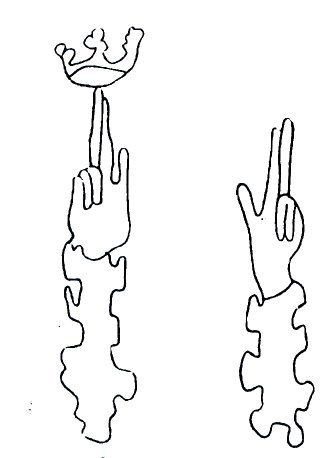 Backbone of OsirisShannon Dorey, Day of the Fish pp. 157-158 |
A hand with a spine, shown above, also appears in the watermarks of the Albigensiens that Howard Bayley associated with the backbone of Osiris in Egyptian mythology.Dorey, Day of the Fish p. 177 In Egyptian mythology the Djed was a rendering of a human backbone. It represented stability and strength. It was originally associated with the creation god Ptah. Himself being called the 'Noble Djed' but as the Osiris cults took hold it became known as the backbone of Osiris. A djed column was often painted on the bottom of coffins, where the backbone of the deceased would lay, this identified the person with the king of the underworld, Osiris. It also acted as a sign of stability for the deceased's journey into the afterlife.Shannon Dorey, Day of the Fish p. 157-158
The "backbone" painted on the bottoms of Egyptian coffins recalls the outline of the skeleton made in the grave of the Dogon Lébé when he/she was being regenerated. Ogotemmêli said, the Nummo's womb had transformed Lébé's "bones into coloured stones, and ejected them into the bottom of the tomb so as to form the outline of a skeleton laid out flat on its back in the place where the body had been, with its head to the north."
It was the dougué stones, which were vomitted forth from the Seventh Ancestor (the Mistress/Master of Speech)and laid out in the outline of a stretched out body, marking the joints of the pelvis and shoulders and where the limbs were attached. Lébé's soul was incorporated into the stones that became the regenerated body. Like the Dogon Lébé, the Egyptian Osiris was born from the mouth of a serpent. "'Osiris entered the tail of a great serpent, was drawn through its body, came out through its mouth, and was then born anew.'"Shannon Dorey, The Master of Speech p.213
Footprints and a hand on a pole, resembling a spine, appear on page 27, of the Kingsborough and Förstemann versions of the Maya Dresden Codex shown below.
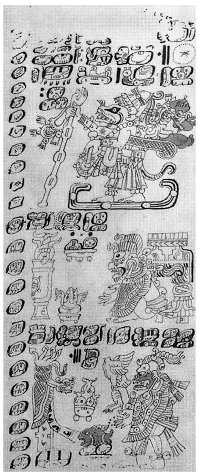
Maya Dresden CodexShannon Dorey, Day of the Fish p. 157
The hand with the spine is being held by the figure in the top section and the footprints appear on the bottom. Strands are shown wrapped around a pole in the middle section along with a severed fish head. An eagle's head is being severed over top of a pot or cauldron in the bottom section and a serpent and fish appear. These severed heads suggest regeneration and the hand and footprints in this image may have meant the same things to the Maya as they did to the Dogon. Heart shaped images appear on the bottom section, which are associated with regeneration in many ancient cultures including Greek mythology and which is discussed in Day of the Fish.Shannon Dorey, Day of the Fish p. 157 Hearts appear on the bottom of the Thracian Stele of Sabazius on the horse, shown above.
 Copper Sandal and MitochondriionShannon Dorey, Day of the Fish p. 155 |
While the hand symbolism is associated with chromosomes in the Dogon religion, I believe the footprints have to do with the mitochondrion of a cell. The print of the crushing, which is supposed to rid the Earth of the Jackal's genetic makeup, is described as the imprint of a copper 'sandal'. Copper was associated with the Nummo whereas iron was identified with the Earth and humans. Mitochondria are described as being "slipper shaped organelles that are double-membraned." The sandals shown above left are replications of Dogon drawings of the sandal relating to the footprint of the crushing. The picture beside it shows the mitochondrion of a cell.
A mitochondrion has its own genome, present in only one copy, which does not recombine in reproduction. Because the genetic material found in the mitochondrion is passed from females to their offspring without recombining, this genetic consistency makes mitochondrial DNA an important tool in tracking genetic histories. I refer to "Mitochondrial Eve" in my books The Nummo and Day of the Fish because of her significance to the Dogon religion.
"Mitochondrial Eve" is the name given by researchers to the woman who was the most recent common matrilineal ancestor of all humans living today. She was a member of a population of humans living around 200,000 years ago in Africa and was identified through "mitochondria organelles" that are only passed from mother to offspring. In the Dogon religion Michondrial Eve was identified with the hermaphroditic Lébé.
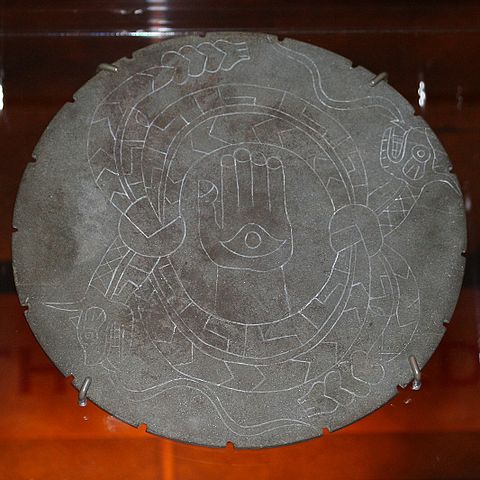 The Rattlesnake Disk, AlabamaShannon Dorey, Day of the Fish p. 159 |
Hand and foot symbolism appear on this image known as "The Rattlesnake Disk." It is a ceremonial stone palette plowed up by a 19th century farmer in Moundville, Hale County, Alabama, United States and housed in the Jones Archaeological Museum at the Moundville Archaeological Park. The importance of this disk, aside from it being circular is that it has dual serpents on it and a hand with an eye in the centre. The serpents on this disk also have horns, which was a characteristic of the Nummo. In the Dogon religion, human creation was identified with the opening of Amma's eyes, which was linked to Amma's keys, doors, and hands. Eye symbolism is important in Dogon mythology. The universe was formed when Amma opened his eyes. As the eye "burst forth from the hole, [it] had become a light that illuminated the universe and revealed the existence of all things in their formation." Amma's hands appear at the end of the sun's rays in Dogon drawings.Shannon Dorey, Day of the Fish p.158
When Amma formed the world, he tied four knots, each of which constituted a seat of the universe. The Dogon said the rope Amma used was like a snake knotted at the four cardinal points and which surrounded the world in formation. Clifford Richey identified the knots on the RattleSnake Disk with V's which we know from the Dogon religion were Amma's hands, door and eyes, and associated with chromosomes. He also said that the Serpent's body's internal signs were composed of multiple feet.Shannon Dorey, Day of the Fish p.160
Richey also pointed out that the overall pattern of the disk showed the image of a Buffalo Head. He used historical information from Paul Raden's Notebook on the Winnebago Tribe to try to get an understanding of what the Buffalo Head might have meant on this disk. Raden said that when "Earthmaker created our world, he saw that his creation was unstable." This reminds us of Amma's creation of the Jackal in the Dogon religion. Raden compared the spiritual origin of the land to a gigantic buffalo whose chief was a complex deity known as Blue Horn, who was also one of the "chief Water Spirits," which is why he was called "Blue Horn." This associates this figure with the Nummo who not only had a horn but were also identified as Water Spirits by the Dogon. I believe that the buffalo took the place of the ram in North America.
The Navaho and other North American plains tribes were said to have carried ammonites in their medicine bags for health and good hunting. They called some of these fossils, buffalo stones because of their resemblance to the horns of the North American bison.Shannon Dorey, Day of the Fish p. 161 Ammonite fossils were connected to the Egyptian oracle god Ammon by Pliny the Elder, who died in 79 AD near Pompeii. He called the fossils of these animals "ammonis cornua, 'horn of Ammon.'" In The Nummo I associate the Dogon Amma with the Egyptian Ammon, who like Amma was known as "the hidden one." Ammon was frequently represented as a ram or as a human with a ram's head.Shannon Dorey, The Nummo p. 253
Read about the back hand of Sabazius in Part II.
For more information on the Dogon religion refer to my books, The Master (Mistress) of Speech, The Nummo, Day of the Fish and The Rose.